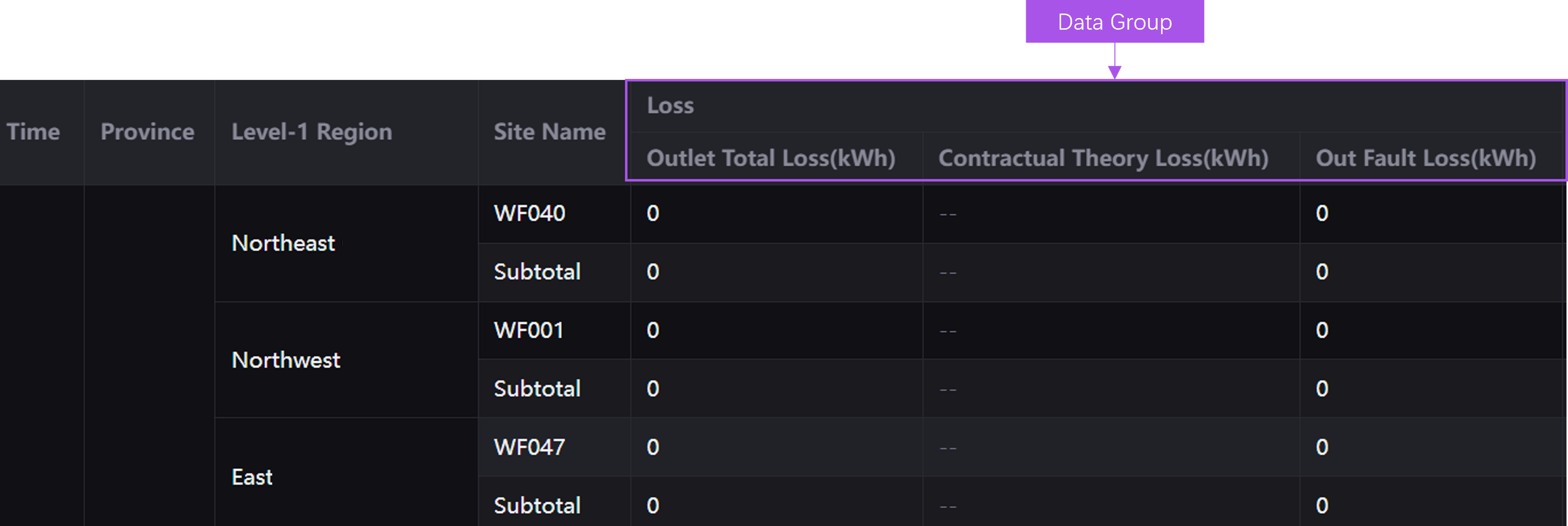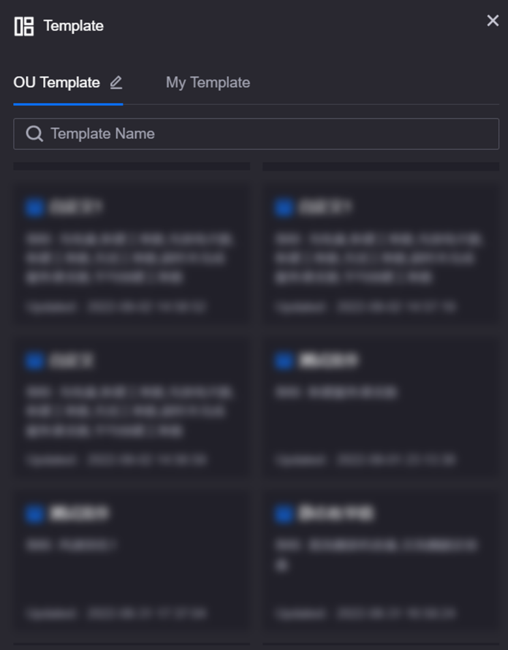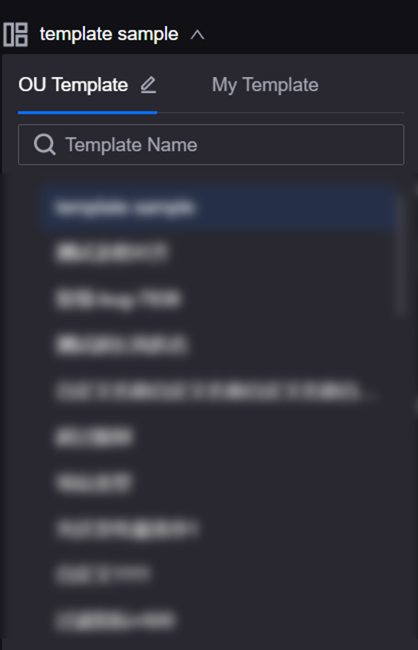Configuring Common KPI Inquiry¶
This page describes how application creators configure Common KPI Inquiry to build reports for data inquiry.
Prerequisites¶
Before you start, make sure that:
You have been assigned with the required asset permissions, operational permissions, and a menu group containing the Common KPI Inquiry page. If not assigned, contact your application administrators.
You have registered the attributes, measurement points, and metrics of target assets in Common Data Service (CDS). For more information, see About EnOS Common Data Service.
You have registered dimension types in Common Data Service. For more information, see Registering a Dimension Type.
Configuring Page Functions¶
Select Common KPI Inquiry from the left navigation pane.
Note
The menu name in your applications might be different from the name in this article, because of the customization on menu names for Unified Monitoring pages. Contact your application administrators for more information.
Select Function Configuration
 in the Common KPI Inquiry page.
in the Common KPI Inquiry page.Configure the following information in the Function Configuration page.
Field
Description
Example
Asset Granular
Specify the scopes available in Asset Granular when configuring the query conditions, including
Site,Device Group, andDevice.For more information about the asset granular of Common KPI Inquiry, see Configuring Query Conditions.
Asset Type
Specify the asset types available in Asset Type when configuring the query conditions.
For more information about the asset type in the Common KPI Inquiry page, see Configuring Query Conditions.
Display Order
The display order of each asset type in Common KPI Inquiry. Asset types can be displayed
By Asset Tree OrderorBy Selection Order.By Asset Tree Orderrefers to the order of nodes in the Organization Structure of Application Portal.By Selection Orderrefers to the order you select assets when configuring query conditions.Asset Tree Style
Specify the style of asset trees in device filters and the Asset Scope section when configuring reports, supporting
By HierarchyorBy List. If you select both, a style switching button appears in device filters and the Asset Scope section.By Hierarchyinherits the hierarchical structure of Organization Structure in Application Portal.By Listdisplays the devices in the site by asset type.Multi-Site Device Query
Allow to query the data of devices in multiple sites.
If you want to view the device data reports of multiple sites, you can enable this function and select multiple sites in the Select Asset Scope section when Configuring Query Conditions.
Query Device Details
Allow to configure whether a specific device is displayed in Common KPI Inquiry.
If you want to query partial devices in a specific site, you can enable this function and select devices in the Select Asset Scope section when Configuring Query Conditions.
Visual Grouping on Device Type
To display the specified asset types in the Configuration Grouping and Statistics Rules > Asset Type. Enter the visual grouping identifier to display the asset types specified in the visual grouping. For more information, see Configuring Display Fields
For example, if only
Wind Turbineexists in an visual grouping of the wind domain, enter the identifier of this visual grouping, and only Wind Turbine assets are displayed in Configuration Grouping and Statistics Rules > Asset Type.Data Field Group
Data category of data fields when you Select Data > Add Data. Enter the key of field groups to categorize data. For more information, see Configuring Display Fields
In Select Data > Add Data, the data category is as follows.

Filter and Sort
Allow application users to filter and sort data fields.
Enable this function, and application users can select the filter icon
 to filter data that meet the conditions or sort data fields in the reports from smallest to largest or largest to smallest.
to filter data that meet the conditions or sort data fields in the reports from smallest to largest or largest to smallest.Select Publish. In the popup window, enter the description on the Remark text box, and select OK.
Configuring Query Conditions¶
To enable application users to query the assets and asset data during the specified time period, configure the following information on the Common KPI Inquiry page:
Grouping and Statistics Rules: configure the type of assets displayed on the Common KPI Inquiry page, and the statistical rules to display responding data fields.
Asset Scope: configure the assets displayed on the Common KPI Inquiry page.
Data: configure the data fields displayed on the Common KPI Inquiry page.
Time Scope: configure the time interval and time range of the asset data.
Configure the asset, data, and time information displayed on the Common KPI Inquiry by the following steps:
Select Common KPI Inquiry from the left navigation pane.
Select More to open the configuration popup window in the Common KPI Inquiry page.
Enter the following information in the Configure Grouping and Statistics Rules.
Field
Description
Asset Granular
Select the query range of Metric Inquiry Reports, supporting
Site,Device Group, andDevice.Asset Type
Select the type of assets from the dropdown list in the report. If the type you want to choose are not on the dropdown list, contact the system administrator.
You can select one asset type for theDevice GroupandDeviceAsset Granular, and multiple asset types for theSiteAsset Granular.Grouping Level
Configure the group of columns on the Common KPI Inquiry page, displaying as a new list column.
Select Add Grouping Level, select the target grouping levels from the popup window, and select OK. If you want to add another grouping level to the popup window, add a Dimension Type in Common Data Service.Statistical Method
If the grouping level contains different asset dimensions, such as both sites and regions, you can select here how the data are counted, supporting
Detailsto display data for each site or region, andSummaryto display the total data of sites or regions.Select the assets displayed on the Common KPI Inquiry page in the Select Asset Scope section. If the Asset Granular is
device, you can select the hierarchy button to display the assets by hierarchy or by list to get a clearer view on the current asset scope.
to display the assets by hierarchy or by list to get a clearer view on the current asset scope.Select the data fields displayed on the Common KPI Inquiry page in the Select Data by the following ways:
Add a data field: if you want to add a single data field as a column in the report, select Data, select the target data from the popup window, and select OK. The data field displays as a column on the Common KPI Inquiry page.
Add a data group: if you want to add data fields with common characteristics or in the same category, select Group. After adding the group, select the name tag of the group you added, enter the group name and select Data to add data fields to the group. An example of the “Loss” data group displays like this.

Select the name tag of data fields and enter the following information.
Field
Description
Name
Enter the name of the data field.
Unit
Enter the unit of the data field.
Unit Multiplier
Adjust the digit number of data when the data is too large or too small. The data displayed on the Common KPI Inquiry page is the product of the unit multiplier and the original data.
For example, if the original data is10000 Wh, you can configure the Unit asKWhand the Unit Multiplier as0.001to display the data field as10 KWhon the Common KPI Inquiry page.Condition
Configure the condition format of this data field.
Select Add to add a new condition format rule and configure the data range and color of the condition format rule.In the Select Time Scope, enter the following information.
Field
Description
Time Interval
Select the interval of time for the adjacent data on the Common KPI Inquiry, supporting the intersection of the time intervals of all selected data fields. The interval of a data field is defined by the
Intervalparameter when registering the data field in Common Data Service.Time Range
Select the start time and end time of the data on the Common KPI Inquiry page.
Select Apply.
Configuring Filters¶
You can enable filters on the Common KPI Inquiry page, so that application users can use the enabled filters to quick query the target assets or asset data. Configure the filters on the Common KPI Inquiry page by the following steps:
Select Common KPI Inquiry from the left navigation pane.
In the Filter Configuration section, select to enable the following filters:
Filter
Description
Asset Filter
Select the assets displayed on the page.
Grouping Level Filter
Filter assets by grouping level.
Time Filter
Specify the start time and end time of asset data on the page.
Data Filter
Select the data fields displayed on the page.
Select Save.
Managing Report Templates¶
The templates of Common KPI Inquiry contains multiple configuration items such as:
Asset granular and asset type
Grouping level
Statistics rules and aggregation methods
Data fields and the display order of data fields
Time interval and range
Enabling the Template Function¶
Select Common KPI Inquiry from the left navigation pane.
Select Yes in the Function Configuration > Template section.
Select the
CardorDrop Downstyle for the template panel in the Function Configuration > Template Menu Style.Select Save.
The “Card” style displays as below.

The “Drop Down” style displays as below.

Saving or Updating a Template¶
Save the current report configuration as a template or update the configuration of an existing template by the following steps:
Select Common KPI Inquiry from the left navigation pane.
Hover over the setting button
 and select Save Template from the dropdown list.
and select Save Template from the dropdown list.Enter the following information on the popup window.
Field
Description
Template Name
Enter the name of the template.
Template Description
Enter the description of the template.
Template Category
Select a category to which the template belongs.
Template Type
Select OU Template if you want share the template to all users of the current OU. Select My Template and only you can use the template.
Save as OU Default View
Display the template as the Metric Inquiry Report when opening the Common KPI Inquiry page.
Select OK.
Saving the Modified Template as a New Template¶
If you have applied a template to the current page and modified the template configuration, save the modified template as a new template by the following steps:
Select Common KPI Inquiry from the left navigation pane.
Hover over the setting button
 and select Save as Template from the dropdown list.
and select Save as Template from the dropdown list.Enter the following information on the popup window.
Field
Description
Template Name
Enter the name of the template.
Template Description
Enter the description of the template.
Template Category
Select a category to which the template belongs.
Template Type
Select OU Template if you want share the template to all users of the current OU. Select My Template and only you can use the template.
Save as OU Default View
Display the template as the Metric Inquiry Report when opening the Common KPI Inquiry page.
Select OK.
Editing a Template¶
Select Common KPI Inquiry from the left navigation pane.
Select Templates to open the template panel from the top left corner.
Hover over the card (for the “Card” style) or the name tag (for the “Drop Down” style) of the target template and select the edit icon
 .
.Edit the name, description, and category of the template in the popup window and select OK.
Deleting a Template¶
Managing Template Categories
You can use template categories to classify and manage templates according to information such as scenarios, objects, and time range.
Creating a Category¶
Select Common KPI Inquiry from the left navigation pane.
Select Templates.
Select the edit icon
 to open the Category Configuration popup window.
to open the Category Configuration popup window.Select Add and enter a category name. After you create a category, you can add the template to a template category when Saving or Updating a Template, Saving the Modified Template as a New Template or Editing a Template.
Editing a Category¶
Sorting Categories¶
Deleting a Category¶
Restoring History Versions¶
You can view the information about history versions such as version numbers, the users to publish versions, the publishing time of versions, and publishing remarks.If you want to use a history version of Common KPI Inquiry, restore the version by the following steps:
Importing or Exporting Pages¶
You can export the following contents of Common KPI Inquiry in JSON format and import the JSON file to migrate and reuse the configured page:
Page function configuration
Asset and data field configuration
Exporting Page Configuration¶
Importing Page Configuration¶
Configuring URL Parameters¶
Besides the configuration above, application creators can enable or disable more functions by configuring the parameters of the URL. For more information, see URL Parameters.


